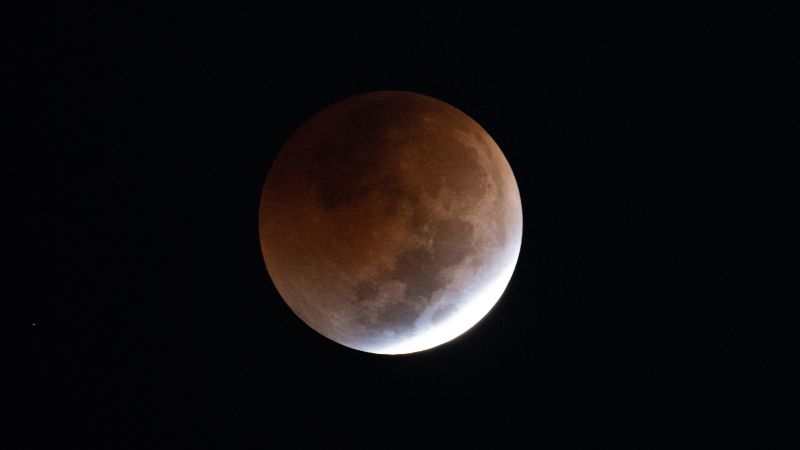A total lunar eclipse is set to dazzle skywatchers this week, transforming the full moon into a striking “blood moon” visible across the Western Hemisphere. NASA has announced that the peak of the eclipse will occur at 2:26 a.m. ET on Friday, lasting for approximately one hour during which the moon will adopt shades of copper, orange, or red. Unlike solar eclipses, which demand special protective glasses for viewing, no such equipment is necessary for observing a lunar eclipse. This month’s large full moon, colloquially known as the “worm moon,” will reach its peak fullness just a few minutes later at 2:55 a.m. ET. Following this impressive celestial display, a partial solar eclipse will be visible in various regions around the world on March 29.
Sky gazers across the Americas, western Africa, and parts of Europe, eastern Australia, New Zealand, northern Japan, and eastern Russia will have the opportunity to witness this celestial event on Thursday evening into Friday morning, depending on local timing and weather conditions. Interested viewers can consult Time and Date’s website to find specific times for their region, ensuring they do not miss this astronomical phenomenon.
The phenomenon of a lunar eclipse occurs when Earth aligns itself between the sun and the moon, forming a near-perfect row, with Earth standing in the middle. As the moon passes into Earth’s shadow, it temporarily acquires a red or copper hue due to the scattering of sunlight through Earth’s atmosphere, a phenomenon known as Rayleigh scattering, earning it the nickname “blood moon.” This effect occurs because the moon is in the darkest part of Earth’s shadow, called the umbra; however, not all of the shadow overlaps perfectly, allowing some sunlight to refract around it, painting the moon in vibrant, warm tones reminiscent of a sunset.
The excitement surrounding this eclipse begins before the total eclipse peak at 2:26 a.m. ET Friday, which will last for just under an hour. As Dr. Renee Weber, the chief scientist at NASA’s Marshall Space Flight Center, stated, March’s weather could impact visibility, as spring showers create a roughly equal chance of cloud coverage. If clouds appear scattered, they could still allow glimpses of the event. Observers aiming to enhance their experience may use binoculars or telescopes; however, lunar eclipses can be enjoyed without any special tools, as simply looking at the full moon is safe for the eyes.
Finding a location away from bright city lights will improve the viewing experience, allowing for a spectacle last seen in November 2022. Unlike the sudden disappearance of the sun during a solar eclipse, the moon will remain visible throughout this lunar eclipse, taking on a dim glow as earthly shadow envelops it. More surrounding dust or clouds in the atmosphere will amplify the reddening effect.
The various phases of the lunar eclipse, which can stretch over six hours, are worth monitoring, starting with the moon’s entry into Earth’s penumbra around 11:57 p.m. ET on Thursday night. This will be followed by the partial eclipse phase at 1:09 a.m. ET, when it will resemble a bite taken from the moon’s surface as it enters the umbra, casting a dark shadow across its face. The total eclipse will occur at 2:26 a.m. ET, lasting 65 minutes, with maximum visibility expected at 2:59 a.m. ET.
As the moon exits the umbra, it will gradually return to its natural brightness by 4:48 a.m. ET, with the eclipse concluding at 6 a.m. ET. Throughout the event, the planets Jupiter and Mars will also be observable in the western sky, providing a unique opportunity to spot constellations against the dimmed backdrop of the moon.
Lunar eclipses always coincide with the full moon. In this instance, the full moon on March 3 is known as the “worm moon,” a title attributed to both indigenous tribes that referenced emerging earthworms in the soil signaling the arrival of spring as well as possibly referring to leafy beetle larvae. Various indigenous groups have their own terms for March’s full moon; the Creek tribe calls it the “little spring moon,” while the Pueblo people refer to it as the “moon when the leaves break forth,” and the Shawnee label it the “sap moon.”
In addition to its picturesque beauty, this full moon is categorized as a micromoon, meaning it will appear about 7% smaller than typical due to its distance from Earth. This week, the moon will be approximately 249,823 miles away, compared to its average distance of 238,855 miles.
Furthermore, since eclipses often occur in pairs, a partial solar eclipse is expected on March 29, where the moon will block a portion of the sun. Different global regions, particularly in Europe, Asia, Africa, and the Americas, will experience this unique event. This pattern of lunar and solar eclips












